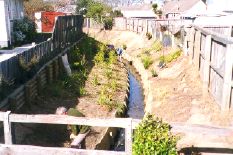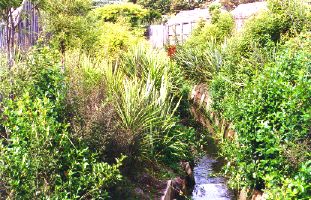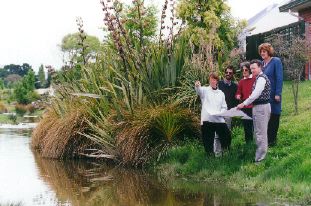
City waterway enhancement projects carried out in the last six years are already boosting native wetland bird populations in Christchurch, according to a leading City ornithologist. Andrew Crossland says that the number of New Zealand Scaup, the small, dark-coloured native diving duck, has doubled in three years to more than 1400 birds. New ponds, including those in Wigram East and the Styx Mill Basin, regeneration of riverbank vegetation and the planting of native species such as sedges, rushes and flax have contributed to the increase.
Numbers of resident-breeding New Zealand Shoveler in Christchurch have risen and the Little Cormorant or White Throated Shag is also more noticeable on City waterways. As well as providing nesting areas for birds, new vegetation is stabilising banks and reducing sediment and nutrient run off in rivers and streams. Mr Crossland says riverbank planting appears to be increasing food sources - small fish, frogs and aquatic insects - allowing the growth of native bird populations in urban waterways.
"It is great to see a range of native bird species begin to move back on to river and pond habitats within urban Christchurch," he says. "In a small way the large piece of built up land which we call urban Christchurch is once again becoming a functioning part of the regional ecosystem. It is now less like a slice of England and more like a part of New Zealand again."
Local streams and wetlands, which until the 1850s teemed with eels, insects, fish and birdlife, deteriorated or even disappeared as the city expanded. Now, as a result of restoration projects, waterways are reverting to their natural character and increasing the City's biodiversity.
The Council and community groups began riverside planting in 1990. These efforts were so successful the Council last year approved a Waterway Enhancement Programme and appointed a Coordinator.
 Shirley Stream before enhancement September 1994 |
The enhancement programme supports community initiatives to improve the city's smaller streams. It aims to work with natural processes to restore streams, creeks and channel waterways by retaining natural stream banks and planting native vegetation. By doing this planting, Christchurch is allowing nature to thrive. Streams act as natural green corridors for birds, fish and insects to move within and beyond the city. |
With people's help, backyards in each neighbourhood of Christchurch are being transformed. Once these were forgotten places. Now they are not only home to wildlife, they are attractive places to enjoy.
| Prompted by the Resource Management Act,
1991, the Council is committed to achieving sustainable management of waterways by working
more closely with communities to restore stream ecosystems for future generations. Many land owners who have waterways or wetlands in or near their properties are already involved or aware of enhancement schemes. People are invited to participate in community workshops to plan and develop the restoration of their local stream. |
 Shirley Stream less than two years later May 1996. |
Assistance is provided by a Council team consisting of an ecologist, planner, engineer and landscape architects. The team coordinates and implements local community restoration plans throughout Christchurch.
Examples of enhancement projects include creating wetlands at Janet Stewart Reserve along the Styx River, removing concrete channels along Jacksons Creek at Cameron Reserve and planting corridors of wetland vegetation along Nottingham Steam in Halswell, Steamwharf Stream in Woolston and Kaputone Stream in Belfast.
For more information contact: Rachel Barker 941 8264
Green "corridors" linking Christchurch's outstanding natural features is a key aim of a natural environment strategy. There is a pressing need for policies which integrate the council's various functions, and respond to natural geographical boundaries. With sustainable management as its overriding objective, the strategy will identify the main threats to the City's natural environment. It will then put forward strategies and practices to manage Christchurch's air, water and land resources.
The Council's Waterway Enhancement Programme is an example of an innovative strategy based on sustainable practices already initiated. Another initiative has been the oxidation ponds at the Bromley sewage treatment plant, which provide an important habitat for birds while playing a key role in the disposal of city effluent.
One of the strategy's main aims will be to create a network of parks and open spaces connected by green "corridors" or greenways along riverbanks, walkways, disused railway lines, the edge of road reserves, and through parks. This open space network will be used to connect the City's outstanding natural features and landscapes such as the Port Hills, the Avon/Heathcote Estuary, rivers and coastline with the city centre.
As well as providing opportunities for recreation, cycleways and pedestrian linkages the green corridor encourages the flow of plants and wildlife. The strategy is aimed at encouraging the management of the city's natural and physical resources in a way that contributes to the health of life support systems rather than degrading them.
 Members of the Waterways enhancement team reviewing a landscape plan at Corsers Stream. |
Space is needed along streams, creeks and
channels for a waterway to function effectively. If fences are required they should be built away from streams and be of open construction to allow movement of water, riverside birds and insect life. |
The Proposed City Plan requires development to be set back 5, 12, 15, 20 and 30 metres from the edge of the bank, depending on the type of waterway. Anyone planning a building, filling or other development near a river, stream or estuary needs to check which setback width applies to them. When development intrudes in the waterway setback, a resource consent application to the Christchurch City Council is required. If consent is granted, conditions may include a requirement to plant local native species along the waterway. Applying for consent is not difficult and council staff can advise you on what needs to be done.
The Christchurch City Council has produced a free Streamside Planting Guide to assist people with planting. It is also preparing brochures on fencing along and across waterways, esplanade reserves and a conservation covenant for waterways and wetlands.
"With people's help, backyards in each neighbourhood of Christchurch are being transformed. Once these were forgotten places. Now they are not only home to wildlife, they are attractive places to enjoy."